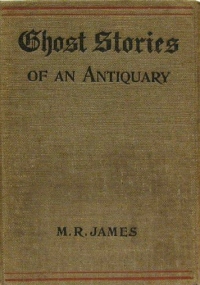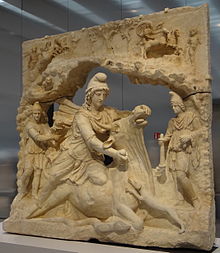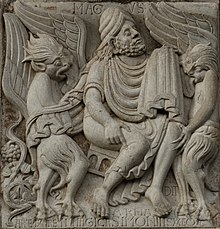Lost Hearts
| "Lost Hearts" | |
|---|---|
| Short story by M.R. James | |
 | |
| Country | United Kingdom |
| Language | English |
| Genre(s) | Horror |
| Publication | |
| Publication date | 1895 |



"Lost Hearts" is a ghost story by British writer M. R. James, originally published in 1895. It was later collected in his 1904 book Ghost Stories of an Antiquary.
Plot summary
[edit]The tale tells the story of Stephen Elliott, a young orphan boy, who is invited to stay with his much older cousin, Mr Abney, at a remote country mansion, Aswarby Hall, in Lincolnshire. His cousin is a reclusive expert on the magico-religious practices of late antiquity who is obsessed with the gaining of occult powers and the acquisition of immortality. Stephen is repeatedly troubled by visions of a young gypsy girl and a travelling Italian boy with their hearts missing.
The occult scholarship of Mr. Abney
[edit]In keeping with the antiquarian interests and considerable personal erudition that this author brings to bear in the settings which he creates for his stories, James provides a considerable amount of background information regarding the field of study of the ruthless and unprincipled classical scholar Mr. Abney - who regards the child murder of orphans as no more than a means to a (black) magical end. Abney’s scholarship encompasses the belief systems of Neoplatonism, the mystery religions of late antiquity - notably Mithraism and Orphism, as well as the pseudoscience/mystical system of alchemy. In the course of the story, Abney mentions not only Censorinus, author of the treatise De die Natali (trans. "Concerning birthdays"), but also the mythical founder of Alchemy Hermes Trismegistus and the biblically-attested magician, and founder of a gnostic sect, Simon Magus.
The spring equinox was approaching, as Mr. Abney frequently reminded his cousin, adding that this had been always considered by the ancients to be a critical time for the young: that Stephen would do well to take care of himself, and to shut his bedroom window at night; and that Censorinus had some valuable remarks on the subject…
…It is recorded of Simon Magus that he was able to fly in the air, to become invisible, or to assume any form he pleased, by the agency of the soul of a boy whom, to use the libellous phrase employed by the author of the Clementine Recognitions, he had "murdered." I find it set down, moreover, with considerable detail in the writings of Hermes Trismegistus, that similar happy results may be produced by the absorption of the hearts of not less than three human beings below the age of twenty-one years.[1]
According to the Early Christian/Gnostic religious romance the Clementine Recognitions (to which James makes his character refer in the second of the two passages quoted above):
Simon claimed that he could make himself visible or invisible at will, pass through rocks as if they were clay, throw himself down from a mountain unhurt, loose himself when bound, animate statues, make trees spring up; throw himself into a fire without harm, appear to have two faces: "I shall change myself into a sheep or a goat. I shall make a beard to grow upon little boys. I shall ascend by flight into the air, I shall exhibit abundance of gold. I shall make and unmake kings. I shall be worshipped as God, I shall have divine honors publicly assigned to me, so that an image of me shall be set up, and I shall be adored as God."[2]
Furthermore (and with particular relevance to the main theme of "Lost Hearts"),
the author of the Clementine Recognitions records an episode in which Simon made a familiar spirit for himself by conjuring the soul out of a boy and keeping his image in his bedroom.
Theosophist G.R.S. Mead provides a fuller account of this episode, furnishing a translation of the lengthier version in the Clementine Homilies, of which the following is an extract.
Simon did not stop at murder, as he confessed to Nicetas and Aquila "as a friend to friends." In fact he separated the soul of a boy from his body to act as a confederate in his phenomena. And this is the magical modus operandi. "He delineates the boy on a statue which he keeps consecrated in the inner part of the house where he sleeps, and he says that after he has fashioned him out of the air by certain divine transmutations, and has sketched his form, he returns him again to the air."[3]
Adaptations
[edit]The story was first adapted for television by ABC and broadcast by ITV on 5 March 1966 as an episode of the Mystery and Imagination series. However, no archive recordings of this episode are known to exist and it is considered lost.
"Lost Hearts" was adapted by Robin Chapman in 1973 as part of the BBC's A Ghost Story for Christmas strand, directed by Lawrence Gordon Clark. The shortest of the adaptations, Lost Hearts was first broadcast on Christmas Day 1973 at 11:35 pm.[4] It starred Simon Gipps-Kent as the orphan Stephen and Joseph O'Conor as the much older cousin. The adaptation is noted for the distinctive hurdy-gurdy music that accompanies appearances of the two ghostly children. Ralph Vaughan Williams' English Folk Song Suite is also featured. Now curated by the British Film Institute, this version of Lost Hearts has been released on DVD sets with other entries in the strand and in December of 2022 on Blu-ray.
In 2018, a third film adaptation[5] of the short story was released by Severn Film Productions[6] in association with Action Image Productions,[7] co-written by Lynn Davies and directed by Max Van De Banks. The production features Nicholas Amer as Mr Abney, Louis Newton as Stephen Elliott, Margaret Baldwin as Mrs Bunch, Mark Llewellin as Mr Parks and Eleanor Catherine Smart as Emily. The film was shot on location at Eastnor Castle and Hellens Manor in Herefordshire and the Gloucestershire Warwickshire Steam Railway. The story is updated to the 1940s (and later 1953) when, following the death of Stephen's parents, the young boy has been evacuated to the countryside during World War II. This production is unusual in that the film was shot in two parts, with the main elements being filmed in 2005 and the beginning and end of the film in 2016, with Louis Newton returning as Stephen, now a young man recounting to his bride-to-be the story of what happened ten years earlier. The film was entered in The Bristol International Film Festival[8] and received a nomination at the Moving Pictures Festival in Nieuwmoer, Belgium in 2018.[9]
References
[edit]- ^
 The full text of Lost Hearts at Wikisource
The full text of Lost Hearts at Wikisource
- ^ Clementine Recognitions, Latin translation by Tyrannius Rufinus (died 410 C.E.) of a now-lost Greek original.
- ^ Mead, G.R.S.,SIMON MAGUS, An Essay on the Founder of Simonianism, Based on the Ancient Sources, With a Re-Evaluation of His Philosophy and Teachings, pub. The Theosophical Society, London. 1892, Part III.—The Simon of the Legends. Viewable online at The Gnostic Society Library http://gnosis.org/library/grs-mead/grsm_simon_magus.htm Retrieved at 17.18 on Saturday 15/7/23.
- ^ "Lost Hearts". British Film Institute Database. Archived from the original on 16 January 2009. Retrieved 22 August 2010.
- ^ "Lost Hearts". Lost Hearts Film. Retrieved 10 December 2019.
- ^ "Reworking of MR JAMES Ghost Story Now Set in WW 2". Severn Film Productions. Retrieved 10 December 2019.
- ^ "Action Image Productions". Action Image Productions.
- ^ "Severn Film Productions". Facebook. Retrieved 10 December 2019.
- ^ "LostHearts Film UK". Twitter. Retrieved 10 December 2019.
External links
[edit] The full text of Lost Hearts at Wikisource
The full text of Lost Hearts at Wikisource- An omnibus collection of James's short fiction at Standard Ebooks
 Lost Hearts public domain audiobook at LibriVox
Lost Hearts public domain audiobook at LibriVox- Lost Hearts at IMDb (1973)
- Lost Hearts at IMDb (2018)
- Ghost Stories at the BFI's Screenonline
